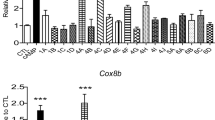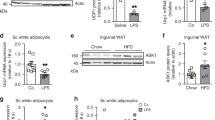Abstract
Objective:
We have recently shown the in vivo anti-obesity effects of sodium tungstate. In this study, we investigate the in vitro effects of sodium tungstate on adipocyte differentiation and function.
Methods:
3T3-F442A cells were allowed to differentiate in the presence of sodium tungstate, and were analyzed for triglyceride (TG) accumulation, adipocyte differentiation and mitochondrial oxygen consumption.
Results:
Sodium tungstate treatment of adipose cells decreased TG accumulation and adipocyte differentiation. Expression of key genes for adipocyte function (aP2, ACC, fatty acid synthase (FAS) and lipoprotein lipase (LPL)) and differentiation (CCAAT enhancer-binding protein (C/EBP)α and peroxisome proliferator-activated receptor gamma (PPARγ)) was reduced by sodium tungstate, whereas C/EBPβ isoform LIP expression level was increased. TG accumulation and changes in C/EBPβ expression were partially recovered by inactivating the erk1/2 pathway. Finally, tungstate treatment increased the oxygen consumption of adipose cells without changes in the expression of oxidative genes.
Conclusions:
Sodium tungstate inhibits adipocyte differentiation by promoting the translation of LIP, a master dominant-negative regulator of this process, and regulates the mitochondrial oxygen consumption of adipose cells. These effects contribute to the anti-obesity activity of sodium tungstate and confirm its potential as a powerful alternative for the treatment of obesity.
This is a preview of subscription content, access via your institution
Access options
Subscribe to this journal
Receive 12 print issues and online access
$259.00 per year
only $21.58 per issue
Buy this article
- Purchase on Springer Link
- Instant access to full article PDF
Prices may be subject to local taxes which are calculated during checkout




Similar content being viewed by others
References
James WP . The epidemiology of obesity: the size of the problem. J Intern Med 2008; 263: 336–352.
Claret M, Corominola H, Canals I, Saura J, Barcelo-Batllori S, Guinovart JJ et al. Tungstate decreases weight gain and adiposity in obese rats through increased thermogenesis and lipid oxidation. Endocrinology 2005; 146: 4362–4369.
Barbera A, Gomis RR, Prats N, Rodriguez-Gil JE, Domingo M, Gomis R et al. Tungstate is an effective antidiabetic agent in streptozotocin-induced diabetic rats: a long-term study. Diabetologia 2001; 44: 507–513.
Munoz MC, Barbera A, Dominguez J, Fernandez-Alvarez J, Gomis R, Guinovart JJ . Effects of tungstate, a new potential oral antidiabetic agent, in Zucker diabetic fatty rats. Diabetes 2001; 50: 131–138.
Fernandez-Alvarez J, Barbera A, Nadal B, Barcelo-Batllori S, Piquer S, Claret M et al. Stable and functional regeneration of pancreatic beta-cell population in nSTZ-rats treated with tungstate. Diabetologia 2004; 47: 470–477.
Barcelo-Batllori S, Corominola H, Claret M, Canals I, Guinovart J, Gomis R . Target identification of the novel antiobesity agent tungstate in adipose tissue from obese rats. Proteomics 2005; 5: 4927–4935.
Barcelo-Batllori S, Kalko SG, Esteban Y, Moreno S, Carmona MC, Gomis R . Integration of DIGE and bioinformatics analyses reveals a role of the antiobesity agent tungstate in redox and energy homeostasis pathways in brown adipose tissue. Mol Cell Proteomics 2008; 7: 378–393.
Feve B . Adipogenesis: cellular and molecular aspects. Best Pract Res Clin Endocrinol Metab 2005; 19: 483–499.
Farmer SR . Transcriptional control of adipocyte formation. Cell Metab 2006; 4: 263–273.
Farmer SR . Regulation of PPARgamma activity during adipogenesis. Int J Obes (Lond) 2005; 29 (Suppl 1): S13–S16.
Descombes P, Schibler U . A liver-enriched transcriptional activator protein, LAP, and a transcriptional inhibitory protein, LIP, are translated from the same mRNA. Cell 1991; 67: 569–579.
Timchenko NA, Welm AL, Lu X, Timchenko LT . CUG repeat binding protein (CUGBP1) interacts with the 5′ region of C/EBPbeta mRNA and regulates translation of C/EBPbeta isoforms. Nucleic Acids Res 1999; 27: 4517–4525.
Baldwin BR, Timchenko NA, Zahnow CA . Epidermal growth factor receptor stimulation activates the RNA binding protein CUG-BP1 and increases expression of C/EBPbeta-LIP in mammary epithelial cells. Mol Cell Biol 2004; 24: 3682–3691.
Wilson-Fritch L, Burkart A, Bell G, Mendelson K, Leszyk J, Nicoloro S et al. Mitochondrial biogenesis and remodeling during adipogenesis and in response to the insulin sensitizer rosiglitazone. Mol Cell Biol 2003; 23: 1085–1094.
Choo HJ, Kim JH, Kwon OB, Lee CS, Mun JY, Han SS et al. Mitochondria are impaired in the adipocytes of type 2 diabetic mice. Diabetologia 2006; 49: 784–791.
Vankoningsloo S, Piens M, Lecocq C, Gilson A, De Pauw A, Renard P et al. Mitochondrial dysfunction induces triglyceride accumulation in 3T3-L1 cells: role of fatty acid beta-oxidation and glucose. J Lipid Res 2005; 46: 1133–1149.
Carmona MC, Louche K, Lefebvre B, Pilon A, Hennuyer N, Audinot-Bouchez V et al. S 26948: a new specific peroxisome proliferator activated receptor gamma modulator with potent antidiabetes and antiatherogenic effects. Diabetes 2007; 56: 2797–2808.
Hutter E, Renner K, Pfister G, Stockl P, Jansen-Durr P, Gnaiger E . Senescence-associated changes in respiration and oxidative phosphorylation in primary human fibroblasts. Biochem J 2004; 380 (Pt 3): 919–928.
Koo DH, Kim M, Chang S . WO3 nanoparticles on MCM-48 as a highly selective and versatile heterogeneous catalyst for the oxidation of olefins, sulfides, and cyclic ketones. Org Lett 2005; 7: 5015–5018.
Choudary BM, Bharathi B, Reddy CV, Kantam ML, Raghavan KV . The first example of catalytic N-oxidation of tertiary amines by tungstate-exchanged Mg-Al layered double hydroxide in water: a green protocol. Chem Commun (Camb) 2001; 18: 1736–1737.
Andreesen JR, Makdessi K . Tungsten, the surprisingly positively acting heavy metal element for prokaryotes. Ann N Y Acad Sci 2008; 1125: 215–229.
Brondino CD, Romao MJ, Moura I, Moura JJ . Molybdenum and tungsten enzymes: the xanthine oxidase family. Curr Opin Chem Biol 2006; 10: 109–114.
Moura JJ, Brondino CD, Trincao J, Romao MJ . Mo and W bis-MGD enzymes: nitrate reductases and formate dehydrogenases. J Biol Inorg Chem 2004; 9: 791–799.
Deeks ED, Keam SJ . Rosiglitazone : a review of its use in type 2 diabetes mellitus. Drugs 2007; 67: 2747–2779.
Massi-Benedetti M, Orsini-Federici M . Treatment of type 2 diabetes with combined therapy: what are the pros and cons? Diabetes Care 2008; 31 (Suppl 2): S131–S135.
Barbera A, Rodriguez-Gil JE, Guinovart JJ . Insulin-like actions of tungstate in diabetic rats. Normalization of hepatic glucose metabolism. J Biol Chem 1994; 269: 20047–20053.
Timchenko NA, Wang GL, Timchenko LT . RNA CUG-binding protein 1 increases translation of 20-kDa isoform of CCAAT/enhancer-binding protein beta by interacting with the alpha and beta subunits of eukaryotic initiation translation factor 2. J Biol Chem 2005; 280: 20549–20557.
Welm AL, Mackey SL, Timchenko LT, Darlington GJ, Timchenko NA . Translational induction of liver-enriched transcriptional inhibitory protein during acute phase response leads to repression of CCAAT/enhancer binding protein alpha mRNA. J Biol Chem 2000; 275: 27406–27413.
Karagiannides I, Thomou T, Tchkonia T, Pirtskhalava T, Kypreos KE, Cartwright A et al. Increased CUG triplet repeat-binding protein-1 predisposes to impaired adipogenesis with aging. J Biol Chem 2006; 281: 23025–23033.
Dudaronek JM, Barber SA, Clements JE . CUGBP1 is required for IFNbeta-mediated induction of dominant-negative CEBPbeta and suppression of SIV replication in macrophages. J Immunol 2007; 179: 7262–7269.
Piquer S, Barcelo-Batllori S, Julia M, Marzo N, Nadal B, Guinovart JJ et al. Phosphorylation events implicating p38 and PI3K mediate tungstate-effects in MIN6 beta cells. Biochem Biophys Res Commun 2007; 358: 385–391.
Alonso M, Melani M, Converso D, Jaitovich A, Paz C, Carreras MC et al. Mitochondrial extracellular signal-regulated kinases 1/2 (ERK1/2) are modulated during brain development. J Neurochem 2004; 89: 248–256.
Bijur GN, Jope RS . Rapid accumulation of Akt in mitochondria following phosphatidylinositol 3-kinase activation. J Neurochem 2003; 87: 1427–1435.
Chaudhry A, Zhang C, Granneman JG . Characterization of RII(beta) and D-AKAP1 in differentiated adipocytes. Am J Physiol Cell Physiol 2002; 282: C205–C212.
Livigni A, Scorziello A, Agnese S, Adornetto A, Carlucci A, Garbi C et al. Mitochondrial AKAP121 links cAMP and src signaling to oxidative metabolism. Mol Biol Cell 2006; 17: 263–271.
Augereau O, Claverol S, Boudes N, Basurko MJ, Bonneu M, Rossignol R et al. Identification of tyrosine-phosphorylated proteins of the mitochondrial oxidative phosphorylation machinery. Cell Mol Life Sci 2005; 62: 1478–1488.
Bender E, Kadenbach B . The allosteric ATP-inhibition of cytochrome c oxidase activity is reversibly switched on by cAMP-dependent phosphorylation. FEBS Lett 2000; 466: 130–134.
Hojlund K, Wrzesinski K, Larsen PM, Fey SJ, Roepstorff P, Handberg A et al. Proteome analysis reveals phosphorylation of ATP synthase beta-subunit in human skeletal muscle and proteins with potential roles in type 2 diabetes. J Biol Chem 2003; 278: 10436–10442.
Lee I, Salomon AR, Ficarro S, Mathes I, Lottspeich F, Grossman LI et al. cAMP-dependent tyrosine phosphorylation of subunit I inhibits cytochrome c oxidase activity. J Biol Chem 2005; 280: 6094–6100.
Schulenberg B, Aggeler R, Beechem JM, Capaldi RA, Patton WF . Analysis of steady-state protein phosphorylation in mitochondria using a novel fluorescent phosphosensor dye. J Biol Chem 2003; 278: 27251–27255.
Steenaart NA, Shore GC . Mitochondrial cytochrome c oxidase subunit IV is phosphorylated by an endogenous kinase. FEBS Lett 1997; 415: 294–298.
Acknowledgements
The CIBER de Diabetes y Enfermedades Metabólicas Asociadas is an ISCIII project. This work was supported by the ISCIII projects CP07/00152, PI04/2553, and by the MEC project SAF 2006-07582.
Author information
Authors and Affiliations
Corresponding author
Rights and permissions
About this article
Cite this article
Carmona, M., Amigó, M., Barceló-Batllori, S. et al. Dual effects of sodium tungstate on adipocyte biology: inhibition of adipogenesis and stimulation of cellular oxygen consumption. Int J Obes 33, 534–540 (2009). https://doi.org/10.1038/ijo.2009.34
Received:
Revised:
Accepted:
Published:
Issue Date:
DOI: https://doi.org/10.1038/ijo.2009.34
Keywords
This article is cited by
-
Reactive-oxygen-species-mediated Cdc25C degradation results in differential antiproliferative activities of vanadate, tungstate, and molybdate in the PC-3 human prostate cancer cell line
JBIC Journal of Biological Inorganic Chemistry (2012)



